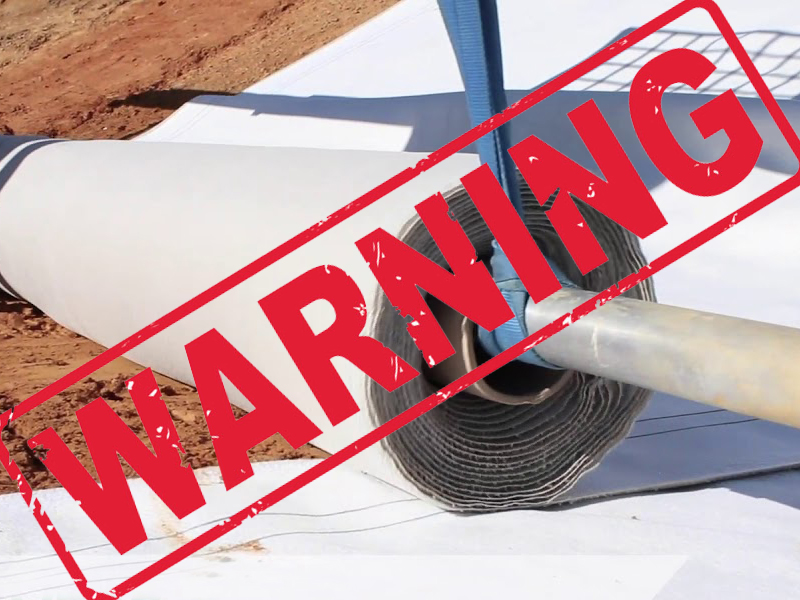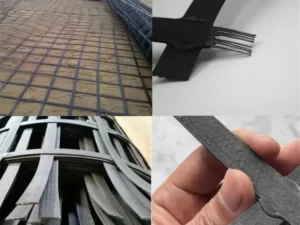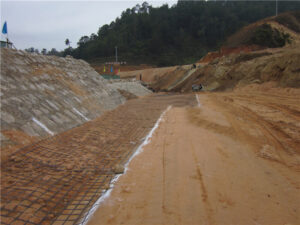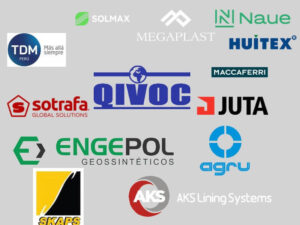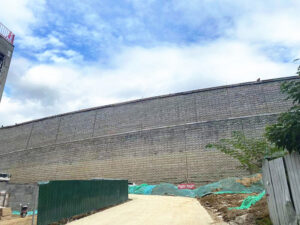What should you pay attention to when installing a bentonite liner? While the margin for error in installing this type of geosynthetic material is relatively high, focusing on the details can make your project more perfect and durable.
The installation of bentonite liners can be broadly categorized into two methods:
- Directly Applying Bentonite: Spread bentonite evenly over the soil.
- Installing Geosynthetic Clay Liners (GCL): A synthetic material consisting of bentonite sandwiched between two layers of геотекстиль.
In this article, QIVOC mainly focuses on the precautions for installing Geosynthetic Clay Liners (GCL), covering aspects such as subgrade preparation, GCL preparation, installation, overlap, backfilling, and other construction details.
First, let’s understand how bentonite liners work:
Bentonite liners, also known as Geosynthetic Clay Liners (GCL), are specifically used for waterproofing in artificial lakes, water features, landfills, underground garages, rooftop gardens, ponds, oil storage facilities, and chemical containment areas.
These liners are made by filling highly expansive sodium bentonite between specially designed composite geotextiles and nonwoven fabrics, and they are produced using needle-punching techniques.
Inside the liner, numerous small fiber spaces are created, preventing the bentonite particles from flowing in one direction. When exposed to water, the bentonite forms a uniform, high-density, gel-like waterproof barrier within the liner, effectively preventing water seepage.
Next, regarding the steps for bentonite liner installation, you can click here to view the detailed guide.
Precautions for Preparing the Base Layer (Supporting Layer, Cushion Layer) for Bentonite Liner Installation:
(1) The base layer can be divided into soft and hard foundations. Before laying the GCL, necessary equipment should be used to level and compact the base, ensuring a compaction rate of over 85%. The surface should be smooth and flat, without protruding rocks or other objects over 2 cm, and no obvious cavities.
(2) The upper layer of the artificial lake foundation must not contain toxic or harmful substances.
(3) The surface should be mostly dry without visible water accumulation. If there is water, drainage work should be carried out.
(4) The rounding radius of the base layer and inner corners should not be less than 30 cm. If the rounding radius exceeds 40 cm, or even becomes vertical, measures should be taken to secure the liner around the perimeter after anchoring, ensuring compaction without damaging the waterproof liner.
(5) Any penetrating pipelines must be fixed and reinforced with concrete to prevent movement.
(6) Anchor trenches must be dug and compacted according to requirements.
Preparations Before Laying the Bentonite Liner:
(1) Perform material analysis and draft the laying sequence and cutting plan for the bentonite composite waterproof liner. (Ensure all auxiliary tools are fully prepared.)
(2) Inspect the appearance and quality of the bentonite composite waterproof liner, and record and repair any observed mechanical damage, production defects, or holes.
(3) The installation of the bentonite composite waterproof liner should be carried out in dry weather, free from rain or snow. If it rains or snows during construction, cover the GCL with plastic sheeting to prevent premature hydration.
Precautions for Laying the Bentonite Liner:
(1) For laying wide and large rolls of bentonite composite waterproof liners, mechanical methods are recommended. If conditions are not suitable or for narrow, smaller rolls, manual installation can also be used.
(2) Lay the bentonite composite waterproof liners in sections, following the prescribed sequence and direction.
(3) When laying the bentonite composite waterproof liners, the seams between the liners should be staggered and should not form continuous seams.
(4) The overlapping areas of the bentonite composite waterproof liner must be free from impurities such as sand, water (including dew), or other substances that could affect the quality of the overlap.
(5) When laying the bentonite composite waterproof liner on vertical or sloped surfaces, use pins and washers to secure the liner to prevent it from sliding.
In addition to using steel nails to secure the overlapping and edge areas of the liner, nails should also be added to the center of the liner as needed, depending on the flatness of the surface, to ensure the liner is firmly and smoothly installed on walls and floors. Nail holes can be treated as necessary.
PS: When installing the bentonite composite waterproof liner, lay it along the slope parallel to its length to minimize any sagging or accumulation.
(6) The geotextiles on both sides of the bentonite composite waterproof liner consist of нетканое полотно и woven fabric. When laying the liner, the non-woven fabric should face the side exposed to water. Specifically, on floors, the non-woven fabric should face down, and on exterior basement walls, it should face outward.
(7) When connecting the bentonite composite waterproof liner to pipeline equipment, concrete should be poured at the bottom of the pipeline to prevent the pipeline from moving. The gaps around the pipeline should be filled with bentonite powder and then thoroughly sealed. The waterproof liner around the pipeline should be tightly fastened with thin iron wire.
(8) When using the bentonite composite waterproof liner in hydraulic engineering, special construction methods may be required. Please contact us promptly for detailed instructions.
During installation, the bentonite waterproof liner should be overlapped in the direction of water flow, with the upstream liner overlapping the downstream liner.
(9) To account for subsidence and deformation of the foundation, if necessary, the bentonite waterproof liner can be slightly wrinkled at the bottom with 1-2 folds, each about 100mm in length. The installation height of the liner must exceed the maximum designed water level by approximately 100mm.
(10) When the bentonite composite waterproof liner is used in highway engineering, the construction methods may differ. Please contact us as needed.
(11) For anchoring points, an anchor trench should be set around the perimeter during construction, with a depth of 400mm and a width of 400mm. After laying the bentonite waterproof liner, cover and compact it with soil.
(12) The bentonite composite waterproof liner should naturally lie flat and close to the support layer without being folded or suspended.
(13) If the dimensions of the GCL cannot meet the requirements during large-scale construction, overlapping methods can be used.
(14) Method for Overlapping Bentonite Composite Waterproof Liners:
The overlap width should be 20-25 cm. Evenly spread bentonite dry powder or (bentonite paste) along the edge of the lower layer, 15 cm from the edge, with a width of 15 cm and a weight of 0.4 kg/m². (During overlapping, the bentonite dry powder at the overlap should be sprayed with water to activate adhesion before compacting, ensuring the area is flat.)
(15) During the installation process, the GCL should be regularly inspected for any damage, holes, or other defects.
If any holes or defects are found, they should be promptly repaired by applying bentonite dry powder (or bentonite paste) or by locally covering the damaged area with GCL that extends at least 15 cm beyond the damaged part, along with bentonite dry powder (or bentonite paste). The edges should be treated according to the overlap requirements.
Installation Precautions for Bentonite Liners During Backfilling
Before construction, ensure that the overlap areas, anchoring points, and bentonite waterproof mats are all properly treated. The construction of the protective layer can adopt the following different methods as needed:
1. Backfill with 300mm of plain soil and then compact it.
2. Pour 50-100mm of plain concrete.
3. Backfill with 200mm of yellow sand, or first pour about 50mm of plain concrete and then lay pebbles on top.
4. On vertical surfaces, a single-brick wall can be built as a protective layer on the edge, or a 3-4mm layer of plain concrete can be applied, and reinforced with a wire mesh to enhance the strength of the plain concrete. If the vertical height exceeds 500mm, wire mesh must be used.
Backfilling Construction Requirements for Ensuring the Waterproof Effect of Bentonite Composite Waterproof Mats
Backfilling construction is a crucial step in ensuring the waterproof effect of bentonite composite waterproof mats and must meet the following requirements:
1. The waterproof mat must be installed and backfilling completed on the same day (at most within two days).
2. All backfill soil should preferably be sand or screened soil, free from debris such as stones larger than 10mm.
3. Compaction (or consolidation, vibration, etc.) should be done for every 50cm thickness of backfill soil, with a required compaction density greater than 85%.
4. During the compaction process, care must be taken not to damage the waterproof mat; any damage must be repaired according to requirements.
5. For surface backfilling, the thickness of backfill soil after compaction should be ≥30cm.
Заключение
The installation of bentonite liners may seem straightforward, but there are many important considerations to keep in mind. For different applications, it’s essential to understand the specific precautions to ensure the successful implementation of the project.
QIVOC has extensive project implementation experience in the installation of bentonite liners. If you have any questions, feel free to contact us at any time.

